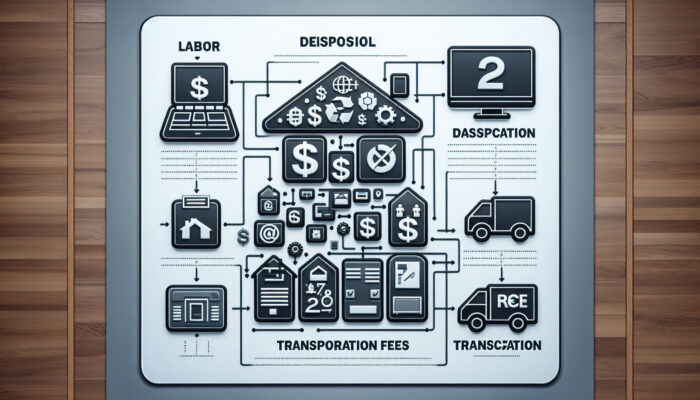Comprehensive Analysis of House Clearance Expenses in the UK
Key Factors Impacting House Clearance Pricing

The expenses associated with house clearance in the UK are shaped by various critical factors that homeowners need to keep in mind. The foremost determinant is the size of the property; larger residences generally necessitate more time, labor, and resources for an efficient clearance. Another vital aspect influencing costs is the total volume of items requiring removal; homes packed with belongings will incur higher expenses compared to those with minimal items. Furthermore, the type of items being cleared plays a significant role in determining costs. For example, bulky furniture and heavy appliances may incur increased disposal charges due to the logistical challenges associated with their removal, making it essential for homeowners to be aware of these factors.
Additionally, if there are items that demand specialized disposal—like hazardous waste or electronic refuse—the costs can escalate considerably. Other important factors to consider include the distance to the disposal site and any supplementary services needed, such as post-clearance cleaning. Understanding these elements is crucial for homeowners, as it not only aids in accurate financial planning but also helps set realistic expectations regarding the overall costs involved in a house clearance project.
To accurately estimate costs, homeowners should take into account these fundamental aspects while preparing for a house clearance:
- Property size and layout
- Quantity and categories of items that need clearance
- Specific disposal requirements for certain items
- Location and ease of access to the property
- Additional services that may be required
Understanding Average Pricing for Various Clearance Services
The average costs associated with house clearance can differ significantly based on the specific type of clearance needed. For a complete house clearance, which entails emptying an entire property, costs generally range from £300 to £1,500. This variation is largely influenced by the size of the property and the total amount of items involved. Conversely, a partial clearance, where only designated rooms or areas are cleared, typically falls between £150 and £800, providing a more budget-friendly alternative for those who do not require comprehensive services.
Specialized clearances, such as those addressing hoarded items or properties overwhelmed with furniture or rubbish, can incur higher costs due to the additional labor and time required to complete the job. Prices for these unique services could start at £500 and increase based on the complexity of the clearance task. Additionally, businesses prioritizing eco-friendly clearances may charge a bit more for their sustainable practices; however, this often results in savings on disposal fees and positively impacts environmental conservation.
It is crucial for homeowners to gather multiple quotes to fully comprehend the pricing structures and what each quote encompasses. This approach empowers them to make informed decisions that align with their financial constraints while ensuring they receive the best value for their house clearance needs.
Steps to Obtain an Accurate Cost Estimate for House Clearance
Acquiring a detailed cost estimate for house clearance is essential for managing expenses and avoiding unexpected charges. Homeowners can effectively achieve this by following several key steps:
- Assess your needs: Clearly define the extent of the clearance required.
- Explore local companies: Identify reputable clearance services in your vicinity.
- Solicit quotes: Reach out to various providers to collect estimates.
- Provide thorough information: Specify the items to be cleared along with their condition.
- Inquire about additional fees: Ask about any potential extra charges that may be applied.
- Compare service offerings: Evaluate what each quote includes beyond just the price.
- Clarify timelines: Understand the duration of the clearance process, as this can affect overall costs.
By diligently following these steps, homeowners can ensure they have a comprehensive understanding of the costs involved, paving the way for a smoother and more efficient house clearance experience.
Professional Tips for Managing House Clearance Costs

Effective Practices for Controlling Clearance Expenses
Successfully managing costs during house clearance relies heavily on meticulous planning and effective negotiation skills. One of the top best practices is to conduct market research to understand the prevailing rates for clearance services in your locality. This knowledge empowers homeowners to negotiate better pricing and avoid being overcharged. Timing can be pivotal; scheduling clearances during off-peak times can lead to substantial savings, as many companies may offer discounts to attract customers during slower periods.
Another practical approach involves sorting items in advance. By categorizing possessions into keep, sell, donate, and dispose, homeowners can significantly decrease the quantity of items that need clearance while potentially recovering some costs through the sale or donation of valuable items. This proactive strategy allows homeowners to recoup some expenses associated with the clearance, making it a financially savvy move.
Moreover, it is crucial to inquire with service providers about any additional savings or package deals they may offer. Numerous companies provide benefits for clients who require repeat services or refer friends, leading to further cost reductions. By implementing these strategies, homeowners can effectively manage their budget while ensuring a successful clearance.
How to Accurately Evaluate the Worth of Items During Clearance
Assessing the value of items during house clearance is a pivotal step in effectively managing costs. When homeowners recognize the worth of their belongings, they can make informed decisions regarding which items to retain, sell, or dispose of. A practical method involves creating an inventory of items within the property, including furniture, electronics, collectibles, and antiques. For instance, checking the resale value of used furniture online via platforms like eBay or local Facebook Marketplace can provide invaluable insights into potential earnings.
Engaging professional appraisers to evaluate higher-value items, particularly antiques or artwork, can yield significant benefits, especially if these possessions carry sentimental value. Their market value may exceed initial expectations, resulting in substantial financial recovery. For instance, a vintage piece of furniture might be worth considerably more than its original purchase price or what one might assume during the context of a clearance.
Furthermore, homeowners should also take into account the emotional value associated with certain items during the clearance process. While some belongings may lack considerable monetary value, their sentimental significance might justify their retention. Striking a balance between emotional attachment and practicality is essential, and a thoughtful assessment can lead to a smoother and more fulfilling clearance experience.
Avoiding Common Mistakes During House Clearance

There are several common pitfalls homeowners should be mindful of during the house clearance process, as these can lead to unexpected costs and delays. A critical mistake is underestimating the volume of items that require clearance. Many individuals presume they have fewer items to clear than actually exist, resulting in inflated costs once the work begins. It is advisable to perform a thorough inventory and assessment well in advance of the clearance date to prevent such surprises.
Another frequent oversight is neglecting to verify the credibility of the clearance service. Always select a reputable company that possesses the proper licensing and insurance. Failing to do so could lead to substandard service, with items potentially being mishandled or disposed of improperly, resulting in legal repercussions for homeowners.
In addition, many individuals overlook the importance of considering recycling options. Not every item needs to end up in a landfill; numerous local charities and recycling centers accept various household items. Taking advantage of these options can not only minimize disposal fees but also have a positive impact on the environment.
Lastly, rushing the process is a common trap that homeowners often fall into. House clearance requires sufficient time and thoughtfulness, particularly when sorting through personal belongings. Taking the necessary time to deliberate over each item can lead to more informed decisions and overall savings.
Understanding the Standard House Clearance Process in the UK
Essential Steps for Completing a Successful House Clearance
The typical house clearance process consists of several organized steps designed to ensure an efficient and thorough experience. Initially, it begins with an assessment, where a professional team evaluates both the property and the items slated for removal. This assessment is crucial for determining the necessary resources, timeframe, and costs involved in the clearance process.
Once the assessment is finalized, the next step is planning, which involves scheduling the clearance date and coordinating with homeowners regarding any specific requirements or concerns they might have. Preparation is essential; clients should ensure they have sorted through their belongings and clearly marked which items should be retained and which can be cleared.
Following the planning phase, the actual clearance occurs. The team will arrive equipped with the necessary tools to safely remove items from the property while ensuring minimal disruption. After the clearance is complete, a critical step is disposal, which involves transporting the cleared items to designated disposal or recycling facilities in compliance with local regulations.
Finally, an optional step is the clean-up, which can be arranged to restore the property to a presentable state following the clearance. Familiarizing oneself with this process enables homeowners to establish realistic expectations and prepare effectively for each phase of the clearance.
Legal Considerations for House Clearance in the UK
Navigating the legal requirements for house clearance in the UK is vital for ensuring compliance and avoiding potential penalties. All waste generated during the clearance process falls under the Environmental Protection Act 1990, which mandates appropriate waste management. Certain categories of waste, particularly hazardous materials, come with specific disposal regulations. Homeowners should confirm that the clearance company they engage is registered as a waste carrier, ensuring compliance with legal frameworks.
Understanding local regulations regarding disposal sites is also essential. Many councils in the UK enforce specific rules regarding what can and cannot be deposited at waste facilities; failure to adhere to these regulations can lead to fines or legal action. Clear communication with the chosen clearance service about these regulations is imperative for maintaining compliance.
Finally, keeping proper documentation is crucial. A legitimate house clearance service should provide a waste transfer note, which serves as proof that the waste has been disposed of legally. This documentation not only protects homeowners but also encourages responsible waste management practices.
Typical Duration for Completing a House Clearance
The time required for a house clearance can vary significantly based on several factors, including the property’s size, the volume of items, and the complexity of the clearance. On average, a standard clearance for a two to three-bedroom house may take anywhere from 4 to 8 hours. However, larger properties or those with substantial clutter might require a full day or even multiple days to complete the task effectively.
Several factors influence the duration of a house clearance, including:
- The size of the property
- The quantity of furniture and personal belongings
- Accessibility of the property (e.g., stairs, narrow spaces)
- Special items requiring careful handling
- Whether sorting or packing is required beforehand
Understanding these factors can help homeowners plan their schedules more effectively, ensuring they allocate sufficient time for the clearance process.
Household Items Suitable for Recycling During Clearance
Recycling during a house clearance not only benefits the environment but can also assist in reducing disposal costs. A variety of household items can be recycled, including:
– Paper and cardboard: Newspapers, magazines, and packaging materials are readily recyclable.
– Glass: Bottles and jars can be taken to recycling facilities.
– Metals: Cans and certain appliances, such as old cookers, can be recycled.
– Wood: Some furniture items or wood scraps can often be repurposed or recycled.
– Textiles: Clothing and linens that are no longer needed can be donated or recycled.
Homeowners should consult with local councils for specific recycling guidelines, as these can differ by region. Engaging with local charities can also be advantageous; many accept donations of usable items, thus supporting community initiatives while reducing landfill waste. By actively recycling items during the clearance process, individuals can positively contribute to environmental sustainability while potentially lowering disposal fees.
Key Considerations When Choosing a Reliable House Clearance Company
Selecting a reputable house clearance company is essential for ensuring a seamless and dependable service. When evaluating potential providers, it is critical to consider several key factors:
– Reputation: Look for companies with positive reviews and ratings. Websites like Trustpilot or Google Reviews can provide insights into the experiences of past customers.
– Experience: Companies with a solid track record in the industry are likely to manage clearances more effectively. Inquire about their experience with similar properties and clearance projects.
– Licensing and insurance: Confirm that the company is fully licensed and insured to carry out clearance services. This ensures protection against liabilities during the process.
– Transparency: A trustworthy company will provide clear and detailed quotes, outlining what is included in the service without hidden fees.
– Customer service: Assess how responsive and helpful the company is during initial communications. Good customer service can reflect their approach once hired.
By thoroughly researching and considering these factors, homeowners can make informed decisions, ensuring they choose a house clearance company that is both reliable and cost-effective.
Advantages of Hiring Professional House Clearance Services
The Expertise Professionals Bring to the House Clearance Process
Professional house clearance services offer extensive expertise that can significantly enhance the efficiency and effectiveness of the clearance process. One of the primary advantages is their comprehensive knowledge of local regulations. Professionals are well-versed in the legal requirements surrounding waste disposal, ensuring that all items are managed in compliance with UK laws, thus preventing potential legal complications for homeowners.
Moreover, professionals possess the necessary equipment and manpower to handle large and cumbersome items safely. This minimizes the risk of injury or damage to property during the clearance process. Their experience enables them to navigate challenges effectively, such as tight spaces or heavy loads, which can often be overwhelming for individuals attempting DIY clearances.
Additionally, professional services frequently have established relationships with recycling facilities and charities, allowing them to dispose of items responsibly and ethically. This network can lead to reduced disposal costs and a more sustainable clearance process. By enlisting professional help, homeowners can enjoy a streamlined and hassle-free experience, assured that their clearance will be conducted efficiently and legally.
Managing Specialized Items During Clearance
Specialized items, such as antiques, electronics, or hazardous materials, require careful handling during a house clearance. Professionals are trained to manage these items with the necessary precautions. For example, electronics must be disposed of according to strict environmental standards and should not be sent to landfills. Professional companies are skilled at identifying these items and ensuring they are processed in compliance with relevant disposal regulations.
When handling antique furniture or collectibles, professionals can assess the value and decide whether items should be sold, donated, or carefully transported to new owners. Their expertise in valuation can significantly offset clearance costs, as high-value items can be sold rather than discarded.
For hazardous materials, such as chemicals or paints, professionals adhere to strict protocols for safe handling and disposal. This is crucial for protecting both the environment and the safety of individuals involved in the clearance. By hiring a professional service, homeowners ensure that specialized items are managed responsibly and effectively, avoiding potential hazards and legal ramifications.
Comparing Costs: DIY Clearance vs. Professional Services
When considering house clearance, homeowners often weigh the cost implications of DIY versus hiring professional services. A DIY clearance might initially seem more economical; however, various hidden costs can arise that make professional services more attractive in the long run. For instance, transporting items to disposal sites can incur costs, including fuel, vehicle hire, and additional fees at waste facilities.
Moreover, the time and effort required for a DIY clearance can be substantial. Homeowners may underestimate the labor involved, leading to extended clearance times and potential frustration. In contrast, professional services complete the task efficiently, often in a fraction of the time.
Additionally, professionals bring expertise in assessing and valuing items, which can lead to financial recovery through the resale or donation of valuable possessions. In many instances, the cost of hiring a reputable clearance service can be offset by the savings realized from proper item management.
Ultimately, while DIY might seem less expensive initially, the potential for additional costs and time investment makes hiring a professional service a prudent choice for many homeowners seeking a seamless and effective house clearance experience.
The Value of a Cost Breakdown Guide for House Clearance
Enhancing Decision-Making with a Cost Breakdown Guide
A detailed cost breakdown guide for house clearance serves as an invaluable tool for enhancing decision-making. It provides homeowners with a thorough understanding of all potential expenses, enabling them to make informed choices regarding their clearance options. By comprehending the full scope of costs involved—from labor and disposal fees to additional services—homeowners can establish more realistic budgets and avoid unwelcome financial surprises.
To effectively utilize a cost guide, homeowners should take actionable steps, such as:
- Reviewing all items to be cleared and categorizing them by type and value.
- Consulting multiple providers to compare prices and services.
- Identifying potential savings through recycling or reselling items.
- Establishing a detailed budget based on the estimates gathered.
- Setting aside contingency funds for unexpected expenses.
By adopting this structured approach, homeowners can significantly relieve financial stress and navigate the house clearance process with confidence and clarity.
Long-Term Savings from Utilizing a Cost Guide
Using a cost breakdown guide can yield substantial long-term savings for homeowners. By providing clarity on anticipated expenses, a cost guide helps prevent overspending during the clearance process. When homeowners have a clear understanding of their financial commitments, they are less likely to incur unexpected costs arising from miscommunication or inadequate planning.
For instance, if a homeowner discovers through a cost guide that certain items can be sold instead of cleared, they can recuperate some of their expenses. Moreover, a comprehensive cost breakdown allows homeowners to prioritize spending, focusing on essential services while identifying areas where costs can be reduced, such as opting for a partial clearance instead of a full service.
Numerous examples exist of homeowners who have benefited from detailed cost guides. Many individuals have recovered significant amounts through the sale of antiques or collectibles identified in the guide, demonstrating how foresight can lead to noteworthy savings. Overall, understanding the complete financial picture equips homeowners with the necessary tools to make decisions that bolster their financial wellbeing over time.
Improving the House Clearance Experience with a Cost Guide
A cost guide enhances the house clearance process by establishing clear financial expectations from the start. When homeowners have a breakdown of potential costs, they can plan accordingly, aligning their budget with the services they require. This understanding promotes effective communication with clearance providers, as homeowners can articulate their needs and constraints more clearly.
The presence of a cost guide also facilitates improved negotiations with service providers. Armed with knowledge about market rates and specific service costs, homeowners can advocate for fair pricing and ensure they receive value for their money. This transparency fosters an environment of trust between homeowners and clearance companies, ultimately leading to a smoother process.
Furthermore, a cost breakdown can highlight areas where homeowners can save money, such as identifying items that may be recycled or donated instead of being disposed of. By optimizing the clearance strategy based on the cost guide, homeowners can streamline the process and reduce unnecessary expenses, making the entire experience more efficient and rewarding.
Promoting Pricing Transparency with a Cost Breakdown Guide
A comprehensive cost breakdown guide promotes transparency throughout the house clearance process by providing homeowners with a clear view of all associated expenses. By outlining every cost element—from labor fees to disposal charges—homeowners can pinpoint exactly where their money is being allocated, enabling informed decision-making.
This visibility is essential for building trust between homeowners and clearance service providers. When companies present clear quotes and itemized estimates, it reflects their professionalism and commitment to ethical business practices. Homeowners can feel confident that they are not being overcharged or subjected to hidden fees, as transparency fosters open dialogue about costs.
Moreover, increased transparency enhances negotiation power for homeowners. With a detailed understanding of costs, they can engage in discussions with service providers more effectively, ensuring they receive fair value. Ultimately, a cost breakdown guide not only clarifies expenses but also cultivates a sense of partnership between homeowners and clearance professionals, contributing to successful outcomes.
A Cost Guide for Effective Budget Planning in House Clearance
Certainly, a cost guide is instrumental in budget planning for house clearance. By providing a comprehensive overview of expected expenses, it allows homeowners to allocate their financial resources effectively, ensuring they have enough funds to cover all aspects of the clearance process. This foresight is pivotal in preventing overspending and financial strain.
Using a cost guide, homeowners can identify specific areas where adjustments to their budgets may be necessary. For example, if they find that certain items can be sold or donated, they might decide to allocate those funds towards additional services, such as cleaning or repairs after the clearance. This flexibility allows homeowners to optimize their finances throughout the process.
Moreover, having a detailed budget based on a cost guide sets the stage for contingency planning. Homeowners can reserve a portion of their budget for unexpected expenses, which is particularly beneficial in scenarios where additional items may need to be cleared or if the property requires extra cleaning. Overall, a cost guide empowers homeowners to approach house clearance with confidence and financial clarity.
Strategic Approaches to Minimizing House Clearance Expenses in the UK
Best Strategies for Reducing Clearance Costs
Reducing house clearance expenses is a primary concern for many homeowners, and implementing strategic measures can yield significant savings. One highly effective strategy is to conduct a thorough pre-clearance sort. By categorizing items into keep, sell, donate, and dispose, homeowners can considerably decrease the amount of items requiring clearance while potentially recovering costs through the sale of valuable goods.
Another tactic involves comparing multiple service providers. Obtaining quotes from various companies can reveal discrepancies in pricing and services offered. This not only facilitates better decision-making but also provides leverage in negotiations, as homeowners may secure a better deal by showcasing competitive quotes.
Additionally, consider timing your clearance strategically. Scheduling your clearance during off-peak seasons can lead to discounts, as many firms often seek to fill slots when demand is lower. Furthermore, engaging in negotiation can yield cost reductions; many companies are open to discussing their pricing, especially if you are booking multiple services or referring them to friends.
Effective communication with your chosen clearance service is also crucial. Clearly articulating your budget constraints can help companies tailor their services to meet your financial needs, ensuring that you receive the best possible value. By adhering to these strategies, homeowners can significantly minimize their clearance costs while ensuring a thorough and efficient process.
How Recycling and Donations Benefit Homeowners During Clearance
Engaging in recycling and donating items during the house clearance process can yield both financial and environmental advantages. Firstly, many local authorities offer reduced disposal fees for items that are recycled, which can substantially lower overall clearance costs. By ensuring that materials such as paper, glass, metal, and certain plastics are properly sorted, homeowners can take advantage of these cost-saving opportunities.
Moreover, donating items to local charities not only diverts waste from landfills but also offers potential tax benefits. Many charities provide tax deductions for donated goods, which can help offset costs associated with the clearance. This dual benefit of contributing positively to the community while saving money makes donations an appealing option for homeowners.
Additionally, connecting with local organizations can enhance community ties. Many charities, such as the British Heart Foundation and local shelters, accept a wide range of household items, addressing community needs while promoting sustainability. This approach not only supports social causes but also positively reflects on the homeowner’s commitment to responsible disposal practices.
By integrating recycling and donations into the clearance process, homeowners can enjoy reduced costs, contribute positively to their communities, and promote environmental sustainability, creating a win-win scenario for everyone involved.
Advantages of Timing Your House Clearance Wisely
Strategically timing your house clearance can yield substantial benefits, particularly regarding cost savings and efficiency. One of the primary advantages is the potential for lower rates. Many clearance companies experience fluctuations in demand, with certain periods being busier than others. By scheduling your clearance during off-peak times, such as mid-week or outside peak moving seasons, you may be able to negotiate better rates or take advantage of special offers.
Furthermore, timing can affect the availability of clearance services. During high-demand periods, homeowners may face longer wait times for services, which can delay the clearance process. Planning ahead and booking during quieter times ensures that you can secure the services you need when you need them, contributing to a smoother overall experience.
Additionally, certain times of the year may coincide with more favorable weather conditions, facilitating a more efficient clearance process. For instance, milder weather in spring or autumn allows for easier access to outdoor items and reduces the likelihood of weather-related disruptions.
Ultimately, being mindful of timing enables homeowners to optimize their house clearance experience, reducing costs, ensuring prompt service, and enhancing overall efficiency throughout the process.
Frequently Asked Questions About House Clearance
What Is the Average Cost for House Clearance in the UK?
The cost for house clearance varies widely, typically ranging from £300 to £1,500, depending on factors such as property size and item volume.
How Long Does a House Clearance Usually Take?
A standard house clearance can take between 4 to 8 hours for a two to three-bedroom home, while larger properties may require a full day or more.
Are There Items That Cannot Be Cleared?
Yes, items like hazardous waste, certain chemicals, and specific types of electronic waste often require specialized disposal and cannot be cleared through standard services.
What Should I Do with Valuable Items During Clearance?
Consider assessing the value of valuable items before clearance. You might sell them online or through auctions, or donate them to local charities.
How Can I Find a Reputable House Clearance Company?
Look for companies with positive reviews, proper licensing, and insurance. Clear communication and a transparent quote process are also good indicators of a reputable service.
Can I Do a House Clearance Myself?
Yes, but a DIY clearance can be time-consuming and may involve hidden costs, such as disposal fees and transportation. Professional services can provide efficiency and legal compliance.
What Are the Benefits of Recycling During House Clearance?
Recycling reduces disposal costs and minimizes environmental impact. It can also provide tax benefits if items are donated to charitable organizations.
Is It Necessary to Sort Items Before Clearance?
Yes, sorting items can significantly reduce the volume to be cleared and may help recover costs through selling or donating items, making the process more efficient.
What Should I Ask a Clearance Company Before Hiring?
Inquire about their experience, licensing, insurance, detailed quotes, and any additional fees that may apply. Clear communication of your expectations is key.
Will I Receive Documentation After the Clearance?
Yes, a reputable clearance company should provide a waste transfer note, which serves as proof of legal disposal of waste and protects you from liability.
Join Our Community on Facebook!
The Article: Cost Breakdown Guide for House Clearance: UK Edition Was First Found At https://birminghamhouseclearance.com
The Article House Clearance Cost Breakdown: A UK Guide Was Found On https://limitsofstrategy.com


Your analysis of house clearance expenses in the UK brings to light several key considerations for homeowners that often go overlooked. The interplay of property size, item volume, and disposal type creates a complex pricing structure that can catch many off-guard during what is often a stressful transition.